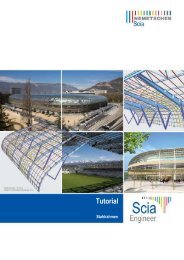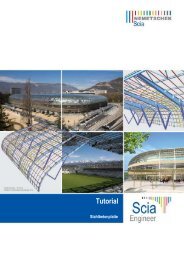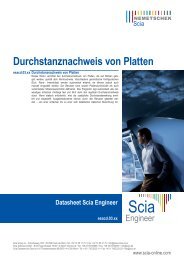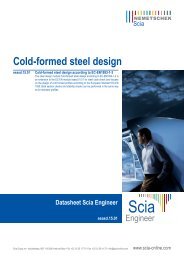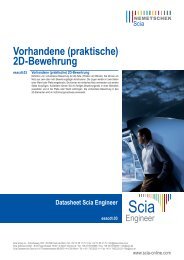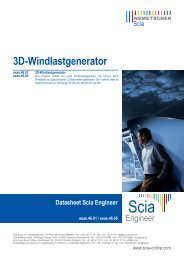Advanced Package Training Scaffolding 2011.1 - Scia-Software GbR
Advanced Package Training Scaffolding 2011.1 - Scia-Software GbR
Advanced Package Training Scaffolding 2011.1 - Scia-Software GbR
You also want an ePaper? Increase the reach of your titles
YUMPU automatically turns print PDFs into web optimized ePapers that Google loves.
9. Non-Linear Combinations<br />
Overview<br />
35<br />
<strong>Scaffolding</strong><br />
Global analysis aims at determining the distribution of the internal forces and moments and the<br />
corresponding displacements in a structure subjected to a specified loading.<br />
The first important distinction that can be made between the methods of analysis is the one that<br />
separates elastic and plastic methods. Plastic analysis is subjected to some restrictions.<br />
Another important distinction is between the methods, which make allowance for, and those, which<br />
neglect the effects of the actual, displaced configuration of the structure. They are referred to<br />
respectively as second-order theory and first-order theory based methods.<br />
The second-order theory can be adopted in all cases, while first-order theory may be used only when<br />
the displacement effects on the structural behavior are negligible.<br />
The second-order effects are made up of a local or member second-order effects, referred to as the Pδ<br />
effect, and a global second-order effect, referred to as the P-Δ effect.<br />
On the next page an overview of the global analysis following the EN 1993-1-1, chapter 5, will be<br />
given:<br />
o All the rules in this overview are given in the EN 1993-1-1 art. 5. For each step the rule will<br />
be indicated. The first rule (αcr > 10) will be explained in EN 1993-1-1 art. 5.2.1(3).<br />
o In this overview 3 paths are defined:<br />
Path 1: In this path a first order calculation will be executed<br />
Path 2: In this path a second order calculation will be executed with global (and<br />
bow) imperfections.<br />
Path 3: In this path a second order calculation will be executed with the buckling<br />
shape of the construction as imperfection.<br />
o The calculation will become more precise when choosing for a higher path.<br />
o The lower paths will result in a faster calculation, because a first order calculation can be<br />
executed without iterations, but this first-order theory may be used only when the<br />
displacement effects on the structural behavior are negligible.<br />
o In the next paragraphs the rules in this overview will be explained.<br />
To take into account all non-linearities in the model, non-linear load combinations are made.



